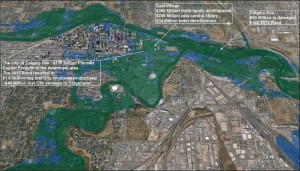The Need for a Comprehensive Flood Mitigation Strategy to Protect the Economic Engine of Canada – Calgary, Alberta
By Calgary River Communities Action Group (CRCAG)

A comparison of the extent of flood inundation on the downtown core and inner city communities – green depicts inundation from the June 2013 flood, blue highlights additional areas that will be inundated by floodwaters if a flood of equal magnitude to the 1879 flood were to hit Calgary. Modeled with a peak flow value of 2265cms for the Bow River (data from Water Survey Canada archived hydrometric data and the City of Calgary) and a regression analyses applied between the Bow and Elbow Rivers to estimate a corresponding flow value of 894cms for the Elbow River. Visualization and modeling conducted by Alberta WaterSmart on behalf of the Calgary River Communities Action Group.
A bigger version of the flood overlay map can be viewed here.
Flooding is the most common hazard in Canada that leads to economic loss. Losses from the 2013 southern Alberta floods alone are estimated to be $6 billion – which is more than four times the losses from all Canadian flood events over the ten-year period preceding 2013.
History has shown that the 2013 flood was not the largest flood experienced by Calgary: the 1879 and 1897 floods were at least 30% larger. A future flood equivalent to the 1897 flood will devastate an even greater extent of the downtown core and inner city communities than experienced in 2013, as highlighted in the visualization above.
Calgarians were recently reminded of the impact a catastrophic event has on the downtown core. As a result of a fire in an underground electrical substation in the downtown’s west-end, 5000 residents were displaced from their homes and nearly 2000 businesses were left without power for five days – even the Premier was without an office. It is apparent from looking at the flood inundation map above, that when a larger scale flood hits Calgary, which it most certainly will, the entire downtown core will be out of commission.
Water and electricity do not work well together, so imagine the October 2014 black-out on a significantly larger scale, where the entire downtown core is without power for weeks. Thousands of residents would be displaced from their homes, and over a 100,000 would have nowhere to return to work. The impact on businesses operating in the core is frightening.
Calgary was built at the confluence of the Bow and Elbow Rivers. The downtown core is in a vulnerable flood plain. Relocation is not an option – nor does that seem desired, particularly in view of the multi-million dollar development plans regularly announced for the East Village – which is vulnerable to flooding. The new 245MM city library will be built near City Hall, which itself was severely impacted by the 2013 flood, leaving City Councillors and many others without offices for months. It’s therefore obvious that reducing the devastating impact of another catastrophic flood requires comprehensive solutions that includes both rivers and must happen as soon as possible.
Recent newspaper articles suggest that the Springbank Off-Stream Diversion does not make financial sense, relying on the AMEC report prepared for the provincial government, which commented briefly on the economics of proposed flood mitigation projects. What does not make sense is why AMEC based its comments about flood damage from the Elbow River on adjusted 1986 data indicating damages of $142MM. Real data from a 1 in a 100 year flood shows the actual damages incurred by the city of Calgary far exceeded that amount – which is well known. CRCAG can only speculate that these conclusions prompted Premier Prentice to submit his own rebuttal. Investing in disaster mitigation strategies has proven to be effective and can result in dramatic returns – no need to look further than Duff’s Ditch completed in 1968 to protect the city of Winnipeg from the Red River, it cost $63MM and has been used over 20 times since and avoided $10B in damages.
The Springbank Off-Stream Diversion will not only protect lives and property, but hundreds of millions of dollars of City infrastructure, private and public capital projects in the downtown core and river communities, and ensure continued prosperity of the economic engine of Canada. The province’s approach makes perfect sense and anyone truly informed about the risks and consequences of flooding to Calgary will agree.
All levels of government have a responsibility to ensure that the impact of the catastrophic events of 2013 is not forgotten and that effective measures are taken to avoid a repeat occurrence. It is only with commitment to a comprehensive mitigation strategy- involving both the Bow and Elbow Rivers – that the economic engine of Canada, the City of Calgary, will be protected.

